
Project countryGermany
Project locationBonn
Architect Stefan Lippert Architekten
Structural engineerR&P Ruffert
Executing companyFritz Meyer
The UN Campus is situated between the former high-rise houses of parliament of the former German capital, Bonn („Langer Eugen“, or Long Eugene) and the World Conference Center Bonn (WCCB). The extensions, with 17 storeys and three basement levels, was conceived with 330 employees in mind. Due to the very limited surface area for a high-rise building, of just 680 m2, the planners kept the encroachment on nature and the environment to the absolute minimum.
The United Nations focuses very strongly on sustainability. The building was designed as a passive house, and the use of natural energy sources is evident from the integration of four excellent conservatories on different floors of the building. Despite the small surface area, 12,000 m2 of sustainably optimized usage areas were created.